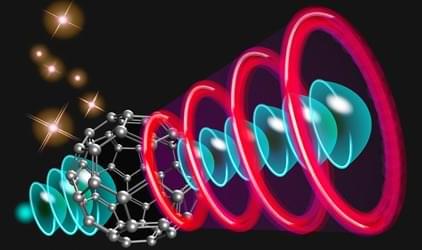The ultimate miniature electronic device may be one that manipulates individual electrons with subnanometer and subfemtosecond precision. The past few decades have seen immense progress in the control of ultrafast electronic processes, including in the context of vacuum nanoelectronics, where electrons travel from a nanoscale emitter to a target electrode through a vacuum. Now Hirofumi Yanagisawa at the Japan Science and Technology Agency and colleagues have taken an important step toward optimal spatial control by using the orbitals of a single molecule to shape its electron emission (Fig. 1) [1]. The approach offers the prospect of building highly controllable electron emitters, but also of furthering our understanding of the role of molecular orbitals in the electronic structure of solids.
Fundamental to achieving extreme control over electron emission is defining the spot from which electrons are ejected from the emitter. One approach is to physically shape the material of the emitter into the desired spot pattern. Doing that at the subnanometer scale would entail significant material-and fabrication-related challenges, however. Instead, Yanagisawa and colleagues have demonstrated the clever idea of using the inherent electronic structure of a molecule to route the electrons for emission. In essence, the molecular orbitals are used as a spatial filter to control the emission pattern.
The team’s work grows out of two broad areas of investigation that have progressed significantly over the past few decades. One of these involves the study of femto-and attosecond electron dynamics and the creation of ultrafast electron sources, exemplified by the 2006 demonstration of tight spatial control over femtosecond electron pulses through emission from a nanoscale metallic tip [2– 8]. The second is the study of electron emission patterns originating from molecular structures and nanostructures. Examples include patterns corresponding to the tip structures of nanotubes and nanowires, which change as the tip evolves during nanotube growth [9– 11]. It is by combining the techniques of ultrafast emission and emission microscopy that Yanagisawa and colleagues have demonstrated that the emission patterns can be directly linked to specific molecular orbitals.









Comments are closed.